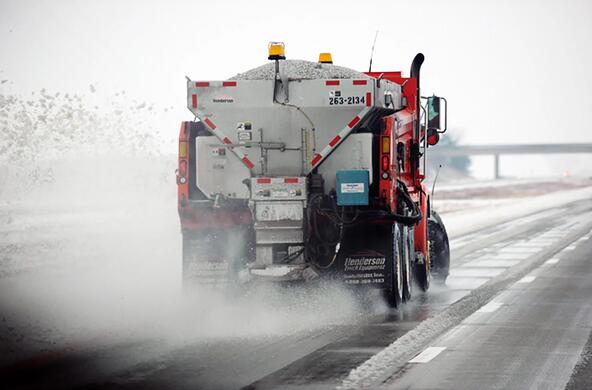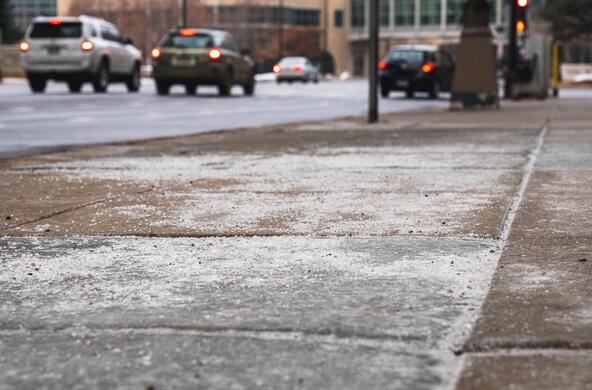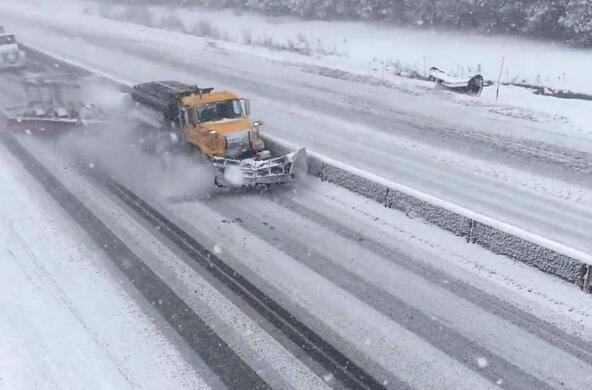Experts and officials look for ways to reduce the use of road salt, which can persist in the environment for many years.
Standing next to a small, unnamed stream near where it empties into Mountain Pond on a cool September day, scientist Dan Kelting reads a sensor he just dipped in the water to measure electrical conductivity, which is used to gauge road-salt concentrations.
Pure water is a poor conductor of electricity, but road salt, or sodium chloride, increases conductivity. Based on the conductivity reading (285 microsiemens per centimeter), Kelting calculates that the water contains 80 milligrams of chloride per liter. This means the stream contains roughly 160 times more chloride than a similar size stream a few miles away.
Why the difference? The stream near Mountain Pond, north of Paul Smith’s College, is downstream from Route 30, a state highway that is heavily salted in the winter. The other stream, which Kelting refers to as Smitty Brook, runs through the Forest Preserve and is upstream of roads.
Both streams are part of a study of road-salt contamination in Adirondack streams, looking at the effects on water quality and soil fertility. Sixteen streams are being monitored with gauges that record the water’s electrical conductivity and height every thirty minutes. Four streams are located upstream of roads and are free of contamination from road salt. These serve as benchmark waterways. The other twelve are located near roads. The waterways are located in the headwaters of the Boquet, Ausable, Saranac, and St. Regis rivers.
Kelting said the salting of roads affects most watersheds in the Adirondack Park. Among the few exceptions are interior waters in the High Peaks Wilderness and the Five Ponds Wilderness.
“Seventy-seven percent of the surface-water area and 52 percent of the stream length of the Adirondack Park is what we called hydrologically connected to our paved roads. We have the potential at least for a serious amount of environmental degradation,” said Kelting, who is executive director of the Adirondack Watershed Institute at Paul Smith’s College.
Kelting, who has conducted road-salt research in the past, is working on the current study with Corey Laxson, a researcher at the institute. The study began in the winter of 2012 and is being funded by AdkAction, the Lake Champlain Basin Program, and Northeastern States Research Cooperative. AdkAction has drawn attention to the road-salt threat by hosting conferences, funding research, and meeting with local and state officials on the issue. This September, with the Adirondack Council, it hosted its third conference on the subject at Paul Smith’s College.
The gathering included scientific presentations from Kelting and Stuart Findlay, an aquatic ecologist with the Cary Institute of Ecosystem Studies in Millbrook. David Wieder of the Colorado Department of Transportation talked about alternative approaches to road salt, including using liquid magnesium chloride. Representatives of New York State’s DOT talked about their approach to applying road salt and some highways where they are testing alternative methods. There were also discussions about the legal issues regarding road safety. More than eighty people attended the conference.
One of the findings of Kelting’s and Findlay’s studies is that road salt remains in the environment—in soils, water, and wetlands—long after it has been applied to pavement. The amount of road salt in the small stream near Mountain Pond was evidence of that.
“The last time that Route 30 was salted was in April,” said Kelting, standing along the stream.
While the Adirondack Watershed Institute study is just a few years old, the Cary Institute has been researching road salt for nearly two decades. It has found long-term trends that road salt accumulates in the environment and that concentrations continue to increase for years, perhaps even decades, after road salt has stopped being applied.
Findlay noted that a study on Saw Kill Creek in Dutchess County revealed that the average annual concentration of chloride has doubled since 1991 from twenty milligrams per liter to forty, despite few changes in the way road salt has been used in the area.
“There are no new roads to speak of, the village engineer says they buy the same amount of salt for the same road miles that they’ve done for years and years and years,” Findlay said. “What’s happening here is that the salt that was applied here years ago is now starting to show up in surface waters. So there’s sort of a residual effect, a slow-release effect, so you’re only seeing the consequences of those decades of salt application after some years.”
Findlay also discovered that concentrations of chloride in the East Branch of Wappinger Creek in Dutchess County were high in the summer months, when water levels are low and fed by groundwater. Kelting has noticed similar trends in Adirondack waterways.
In the Adirondacks, there have been few scientific studies regarding road salt. What is known is that a lot of salt is put on the roads because of the severe winter weather here. The state Department of Transportation’s website says the department used 1,048,760 tons of road salt statewide last winter.
Kelting said that the state applies an average of ninety eight thousand tons of road salt per year to roads in the Adirondacks, which works out to thirty-four tons per lane mile. Local governments put down nearly seventy-seven thousand tons annually, or about ten tons per lane mile.
One thing that concerns Kelting is that the amount of sodium and chloride occurring naturally in the Adirondacks is low, but large quantities have been introduced to the environment.
Consider a small stream off Route 3 near Indian Carry, the portage between Stony Creek Ponds and Upper Saranac Lake. During a warming period in April, the stream monitor detected chloride in the amount of 1,200 milligrams per liter. The average level of chloride for the stream is seventy-eight milligrams per liter, putting it just ahead of the seventy-five milligrams per liter at the stream near Mountain Pond for the highest level in the study’s sixteen streams.
“Those are urban peaks—urban peaks in an Adirondack watershed,” Kelting remarked.
Overall, the average concentration for chloride in the twelve streams downstream of roads is about thirty milligrams per liter of water, while for sodium, it’s twenty milligrams per liter. In contrast, the four streams upstream of roads on Forest Preserve lands have only a quarter-milligram of chloride per liter and a half-milligram of sodium per liter.
High concentrations of road salt can have consequences for human health as well as for wildlife, though Kelting is careful to note that more studies need to be undertaken to get a fuller understanding of its effect on the environment. If sodium chloride, which is the same as table salt, gets into wells, people can be exposed to greater levels of sodium, which can increase blood pressure. Certain animals, including deer and moose, ingest salt crystals, which can be harmful in large amounts.
The New Hampshire Department of Environmental Services warns on its website: “Chloride in surface waters can be toxic to many forms of aquatic life. Aquatic species of concern include fish, macroinvertebrates, insects, and amphibians. Elevated chloride levels can threaten the health of food sources and pose a risk to species survival, growth, and/or reproduction.
… The presence of salt also releases toxic metals from sediment and when released into the water can inhibit nutrients and dissolved oxygen within the water that aquatic species rely on.”
In recent years, the New York State Department of Transportation has taken steps to try to reduce its use of traditional road salt, including cutting its application rate statewide by 10 percent. It’s also improved its salt-storage facilities to prevent runoff. In the Adirondacks, plow trucks have reduced their average speed to twenty-five miles per hour so that less salt will bounce away from the roads when it’s put down.
On four roads in the Adirondacks, DOT has experimented with using less road salt and with using alternative de-icers. (The roads are Route 8 in Hamilton County, Route 3 in Franklin County, and Route 73 and Route 86 in Essex County.) As part of the pilot program, undertaken in partnership with Paul Smith’s College and AdkAction, the department deployed trucks equipped with both a front-end plow and an underbelly scraper.
“It’s kind of like a doubled-edge razor when you’re shaving,” said DOT engineer Mike Lashmet. “The first plow takes off the majority of the material, and the underbelly plow will be like that second blade coming through to get anything that the first blade missed.”
Statewide, DOT is also using more pre-storm anti-icing liquids, which reduces the amount of road salt that must be applied later. In Essex County, road salt is treated with magnesium chloride because it performs better in colder temperatures than traditional road salt and less is needed overall.
“We try to be as environmentally conscious as we can in providing safe roads for the traveling public,” said Lashmet, noting that upstate New York has some of the severest winter weather in the nation.
Adirondack environmentalists have expressed gratitude for DOT’s initiatives, but they say more needs to be done. The September conference fostered an agreement to create an all- volunteer working group to study the costs and effects (on roads, bridges, and water quality) of using alternative de-icers in the Park. The group also will examine roads to see where sunlight can be relied upon to melt snow and ice. Finally, the group will look for funding for further studies of groundwater contamination and salt toxicity and for public education.
Scientists, environmental activists, local elected officials, and employees of local and state highway departments are expected to take part in the working group. “The towns, the villages, the counties, the state are not talking together at the strategic level the way we think they should,” said Lee Keet, one of the founders of AdkAction. “We’re going to try to organize it so they talk to each other regularly and compare notes and techniques and maybe cut back on the costs.”
In the meantime, the Adirondack Watershed Institute will continue its research on how road salt is affecting wetlands, groundwater, soils, and streams.
“We need to get a fuller understanding of the environmental impacts of using road salt,” Kelting said. “We do know the cost of road salt in terms of purchase price, application cost. We can get a good understanding of the effects of salt on infrastructure, cars and bridge abutments and guardrails, but we just don’t have a good understanding of environmental effects, and thus the potential environmental cost.”








